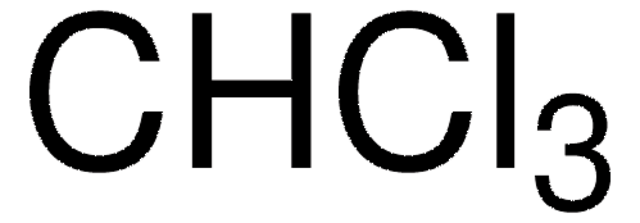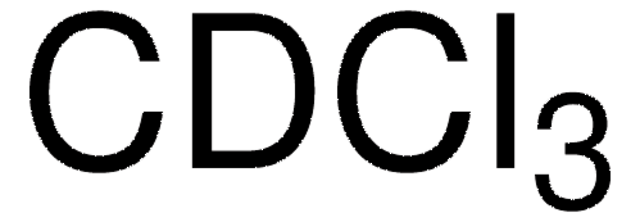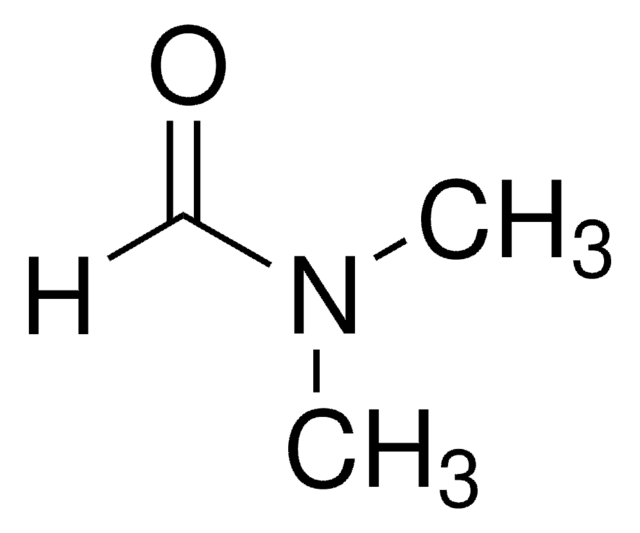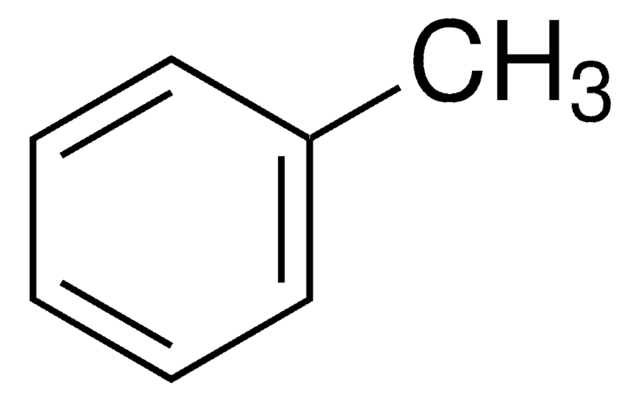437581
Chloroform
ACS reagent, ≥99.8%, contains 0.5-1.0% ethanol as stabilizer
Synonym(e):
Methylidyntrichlorid, Trichlormethan
About This Item
Empfohlene Produkte
Qualität
ACS reagent
Qualitätsniveau
Dampfdichte
4.1 (vs air)
Dampfdruck
160 mmHg ( 20 °C)
Assay
≥99.8%
Form
liquid
Enthält
0.5-1.0% ethanol as stabilizer
Verpackung
PVC-coated bottle of 4x4 L
Abdampfrückstand
≤0.001%
Farbe
APHA: ≤10
Brechungsindex
n20/D 1.445 (lit.)
bp
60.5-61.5 °C (lit.)
60.5-61.5 °C
mp (Schmelzpunkt)
−63 °C (lit.)
Dichte
1.492 g/mL at 25 °C (lit.)
Kationenspuren
Pb: ≤0.05 ppm
SMILES String
ClC(Cl)Cl
InChI
1S/CHCl3/c2-1(3)4/h1H
InChIKey
HEDRZPFGACZZDS-UHFFFAOYSA-N
Suchen Sie nach ähnlichen Produkten? Aufrufen Leitfaden zum Produktvergleich
Verwandte Kategorien
Allgemeine Beschreibung
Anwendung
- Synthesis of colloidal hydrophobic CdSe core nanocrystals (quantum dots).
- Preparing phospholipid solutions.
- As a solvent in the photolysis reaction of ruthenium complexes.
- Solvent for recrystallization.
- As a reference compound to detect the presence of chloroform in tobacco smokes.
- As an extractant in solvent extraction process.
Signalwort
Danger
Gefahreneinstufungen
Acute Tox. 3 Inhalation - Acute Tox. 4 Oral - Carc. 2 - Eye Irrit. 2 - Repr. 2 - Skin Irrit. 2 - STOT RE 1 Oral - STOT SE 3
Zielorgane
Central nervous system
Lagerklassenschlüssel
6.1D - Non-combustible, acute toxic Cat.3 / toxic hazardous materials or hazardous materials causing chronic effects
WGK
WGK 3
Flammpunkt (°F)
does not flash
Flammpunkt (°C)
does not flash
Zulassungslistungen
Zulassungslistungen werden hauptsächlich für chemische Produkte erstellt. Für nicht-chemische Produkte können hier nur begrenzte Angaben gemacht werden. Kein Eintrag bedeutet, dass keine der Komponenten gelistet ist. Es liegt in der Verantwortung des Benutzers, die sichere und legale Verwendung des Produkts zu gewährleisten.
EU REACH Annex XVII (Restriction List)
Choose from one of the most recent versions:
Analysenzertifikate (COA)
Sorry, we don't have COAs for this product available online at this time.
If you need assistance, please contact Kundensupport
Besitzen Sie dieses Produkt bereits?
In der Dokumentenbibliothek finden Sie die Dokumentation zu den Produkten, die Sie kürzlich erworben haben.
Kunden haben sich ebenfalls angesehen
Artikel
Developed in the last several years, fluorescence quenching microscopy (FQM) has enabled rapid, inexpensive, and high-fidelity visualization of two-dimensional (2D) materials such as graphene-based sheets and MoS2.
Unser Team von Wissenschaftlern verfügt über Erfahrung in allen Forschungsbereichen einschließlich Life Science, Materialwissenschaften, chemischer Synthese, Chromatographie, Analytik und vielen mehr..
Setzen Sie sich mit dem technischen Dienst in Verbindung.




